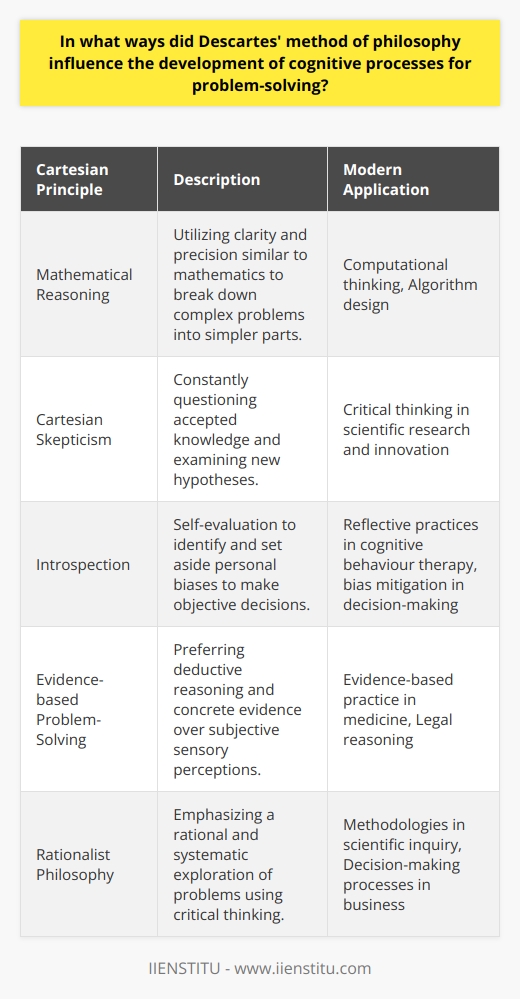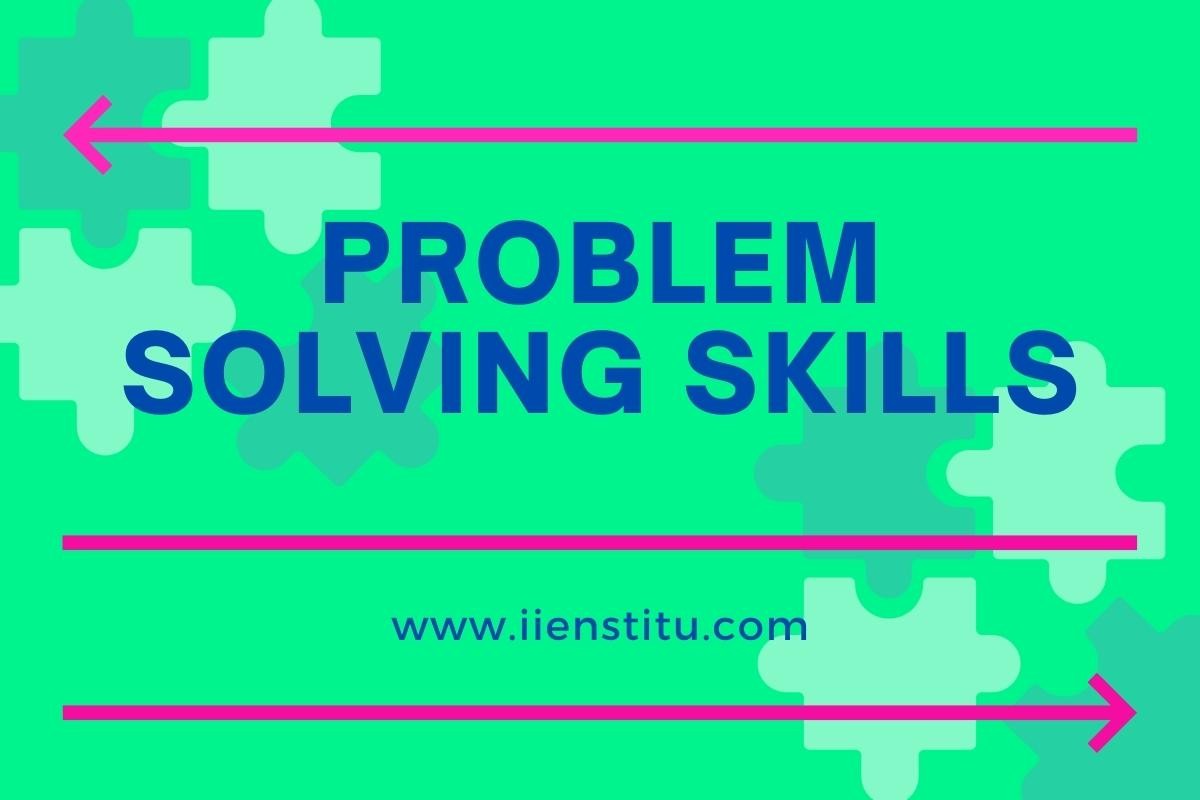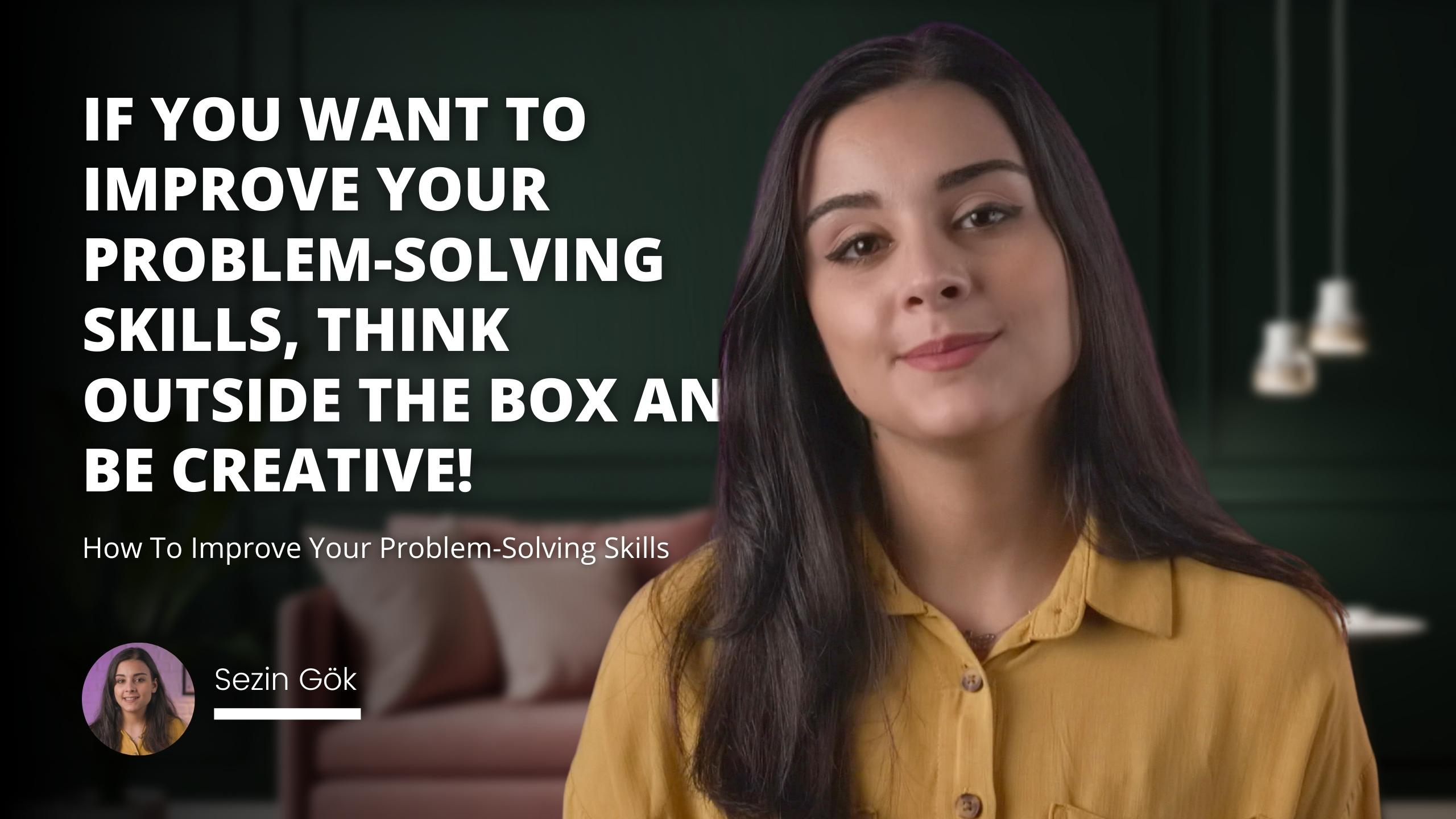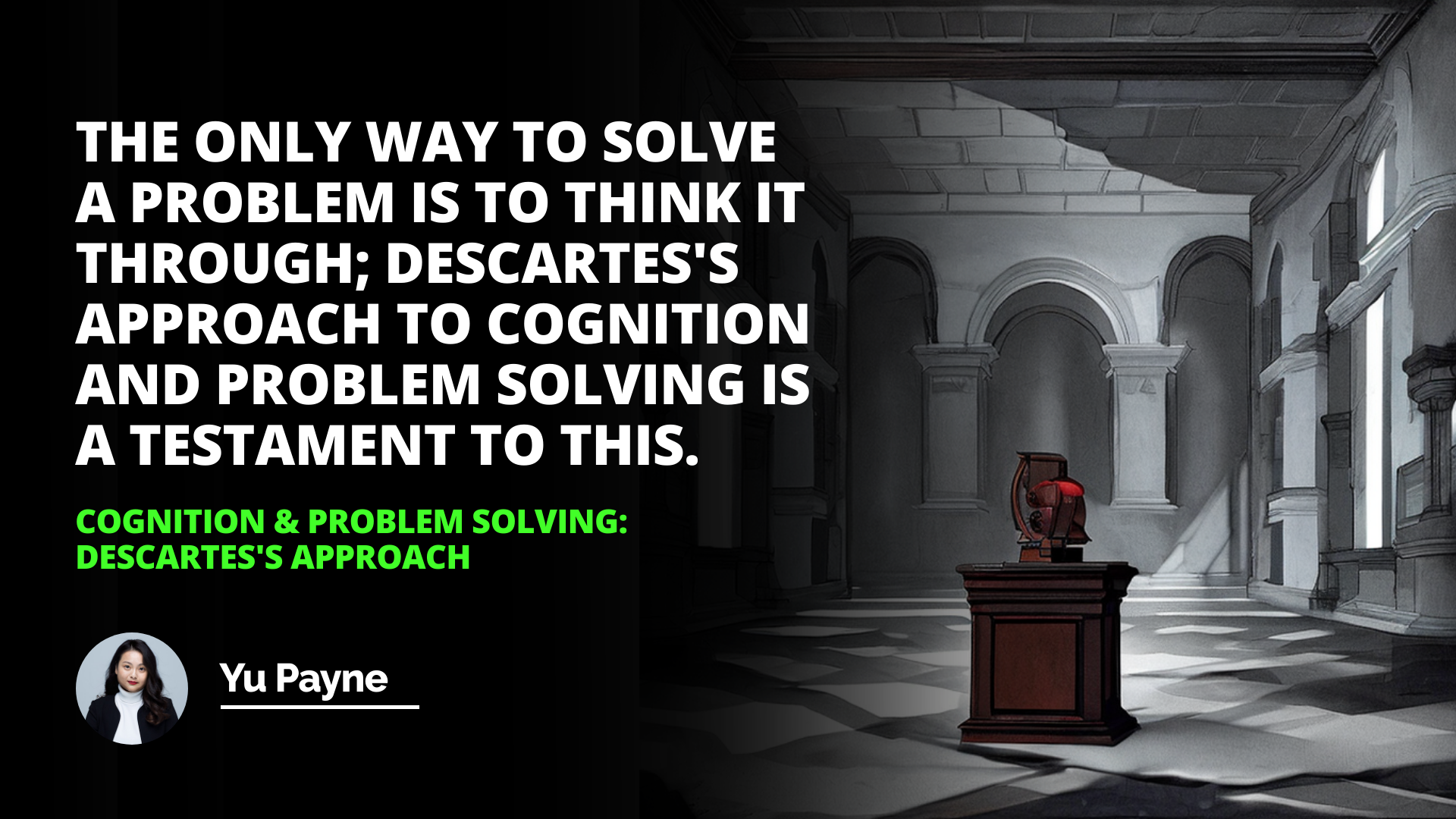
René Descartes is a French philosopher who is considered the father of modern philosophy and is known for his famous phrase, “I think. Therefore I am.” Many modern thinkers have adopted his cognition, ontology, and problem-solving views.
Descartes believed that thinking was the primary attribute of the mind and that it was the basis for all other forms of knowledge. His ontology was based on substances, attributes, and modes, and he argued that all things could be broken down into these three categories.
He was also known for his innovative approach to problem-solving, which involved breaking a problem down into its parts and then analyzing each part separately. His views on cognition, ontology and problem-solving are still relevant.
Introduction
Descartes and Cognition
Descartes' Ontology
Descartes' Problem-Solving Approach
Conclusion
Introduction: René Descartes (1596-1650) was a French philosopher who is often considered the father of modern philosophy. His famous phrase “I think, therefore I am” is one of the most famous philosophical statements of all time. Descartes is also known for his innovative approach to problem-solving, which has been adopted by many modern thinkers. This article will explore Descartes’ views on cognition, his ontology, and his approach to problem-solving.
Descartes and Cognition
Descartes believed that thinking was the primary attribute of the mind. He argued that the ability to think was the only thing that could be known for sure and that it was the basis for all other forms of knowledge. He argued that thinking was the basis of all human activity and that it was the only thing that could be considered “real.” He believed that thinking was a form of cognition and the basis of all knowledge.
Descartes' Ontology
Descartes’ ontology was based on substances, attributes, and modes. He believed that all things could be broken down into these three categories. He argued that substances were the basis of all reality and that they were the basis of all knowledge. He argued that attributes were substances' qualities and were the basis of all understanding. Finally, he argued that modes were how substances and attributes could be combined to create new forms of knowledge.
Descartes' Problem-Solving Approach
Descartes was known for his innovative approach to problem-solving. He believed that the best way to solve a problem was to break it down into its parts and then analyze each part separately. He argued that by breaking a problem down into its parts, it would be easier to identify the underlying causes of the problem and come up with a solution. He also believed that it was essential to consider the context of the problem and think about how the different parts of the problem were related.
Conclusion: In conclusion, Descartes was an innovative thinker who profoundly impacted modern philosophy. Many modern thinkers have adopted his cognition, ontology, and problem-solving views. His famous phrase “I think, therefore I am” is one of the most famous philosophical statements of all time, and it is a testament to his innovative thinking. Descartes’ views on cognition, ontology and problem-solving are still relevant today, and his approach to problem-solving is still used by many modern thinkers.
The only way to solve a problem is to think it through; Descartes's approach to cognition and problem-solving is a testament to this.
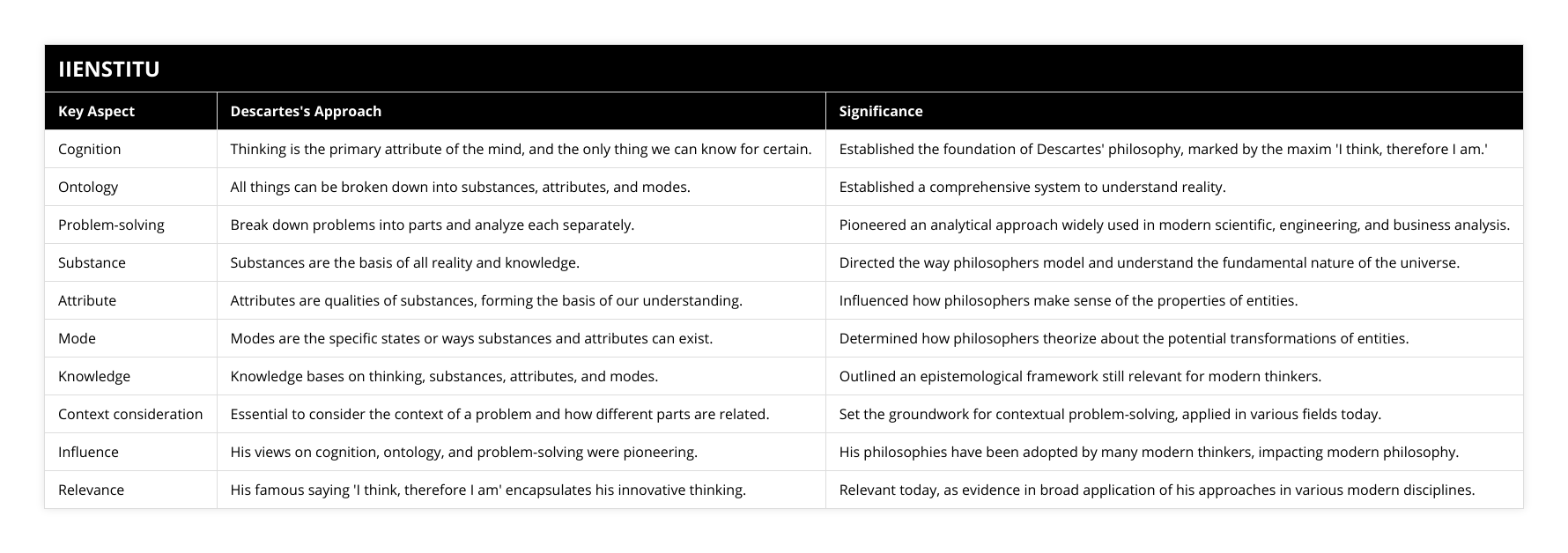
Frequently Asked Questions
What is Descartes' ontology and how does it relate to cognition and problem solving?
René Descartes is widely regarded as one of the most influential thinkers of the modern era. His philosophical ideas have profoundly impacted the fields of epistemology and metaphysics, particularly regarding the notion of ontology. At the heart of Descartes’ philosophy, this concept is widely accepted as the basis for understanding how humans think and solve problems.
Descartes’ ontology is based upon the notion of dualism, which states that humans are composed of both a physical body and an immaterial mind. This is in contrast to the monistic view, which proposes that humans are composed of one substance, either physical or mental. For Descartes, the mind and body are distinct and separate entities, each with its attributes and capabilities. This dualistic view of human nature is known as Cartesian dualism or mind-body dualism.
Descartes believed that the mind is the primary source of knowledge and understanding. He argued that the mind is capable of abstract thought and reasoning and that through this process of cognition, humans can solve problems and make informed decisions. According to Descartes, the mind can form ideas, make judgments, and draw conclusions, all of which are essential for problem-solving.
Descartes’ ontology has significantly influenced the field of cognitive science, particularly regarding the study of problem-solving. By understanding the dualistic nature of human nature, cognitive scientists have been able to understand better how humans think and the processes by which they solve problems. Additionally, Descartes’ ontology has also been used to explore the implications of artificial intelligence and how it relates to human cognition.
In conclusion, Descartes’ ontology is a foundational element of his philosophical system and is widely accepted as the basis for understanding how humans think and solve problems. His notion of dualism has significantly influenced the fields of epistemology and metaphysics, as well as cognitive science and the study of artificial intelligence.
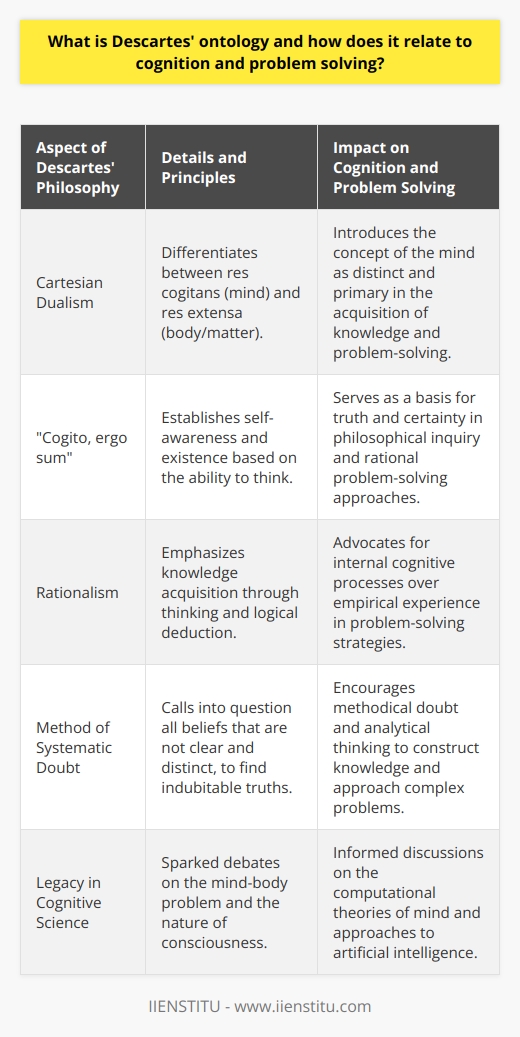
How does Descartes' approach to problem solving differ from other approaches?
Descartes' approach to problem-solving is vastly different from other approaches due to his innovative and unique methodology. He was an early proponent of the scientific method, which involves forming a hypothesis, collecting evidence, and testing it against observations. This method is different from other approaches because it is more methodical and relies on a logical approach to problem-solving.
Descartes' approach is centered around the concept of doubt. He believed that everything can be doubted and questioned and that all knowledge must be questioned before it can be accepted. By constantly questioning and doubting, Descartes believed one could come to a rational conclusion. This approach is known as the Cartesian Method and is based on doubting the validity of any existing knowledge and then building new knowledge from the ground up.
Descartes' approach is also based on logic, as opposed to other approaches, which may rely more on intuition and instinct. Descartes believed in breaking down problems into smaller and simpler parts to understand the issue better and come to a logical conclusion. He used a system of deduction, which involves breaking down data into its core components and then using deductive reasoning to determine the most likely outcome.
Descartes' approach is distinct from other approaches because it is based on the scientific method and is focused on logic and deduction. It is also a more structured and systematic approach to problem-solving. Descartes' approach has had a lasting influence on our modern understanding of problem-solving and has been widely adopted in many areas of science.
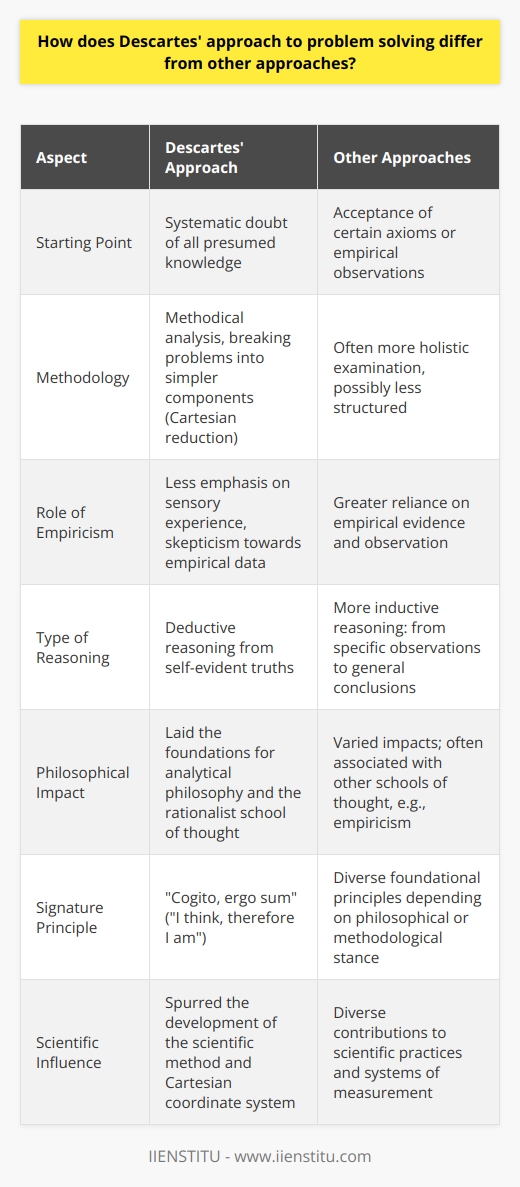
What are the implications of Descartes' approach to cognition and problem solving?
Descartes’ approach to cognition and problem-solving is one of history's most influential philosophical ideas. His approach to these concepts has shaped the way we think about the world and our ability to solve problems. The implications of his approach are far-reaching and can be seen in various fields, including psychology, artificial intelligence, and philosophy.
Descartes’ approach to cognition and problem-solving centers on his belief that the human mind can reason and understand the world. He argued that the mind is a tabula rasa, or blank slate, which can be filled with knowledge and experiences through observation and experience. He also believed that the mind could understand abstract concepts, such as mathematics and logical reasoning. This view of the mind has been influential in psychology, as it has shaped the way we think about the nature of cognition and problem-solving.
Descartes’ approach to problem-solving is based on his belief that the mind can analyze data and form logical conclusions. He believed that the mind could use deductive reasoning and induction to solve problems. The implications of this view of problem-solving can be seen in artificial intelligence. This field has been heavily influenced by Descartes’ approach, as many of the algorithms used in artificial intelligence are based on deductive reasoning and induction principles.
Finally, Descartes’ approach to problem-solving has been influential in philosophy. His view of the mind as a blank slate has been a foundation for many philosophical arguments, such as free will. His view of the mind as a rational creature has also been used as a basis for debates about the nature of ethics and morality.
In conclusion, Descartes’ approach to cognition and problem-solving has profoundly impacted how we think about the world and our ability to solve problems. His view of the mind as a tabula rasa has influenced psychology, artificial intelligence, and philosophy. His approach to problem-solving has also been influential in philosophy, as it has been used as a basis for debates about the nature of ethics and morality. As such, Descartes’ approach to cognition and problem-solving is one of the most influential ideas in history.
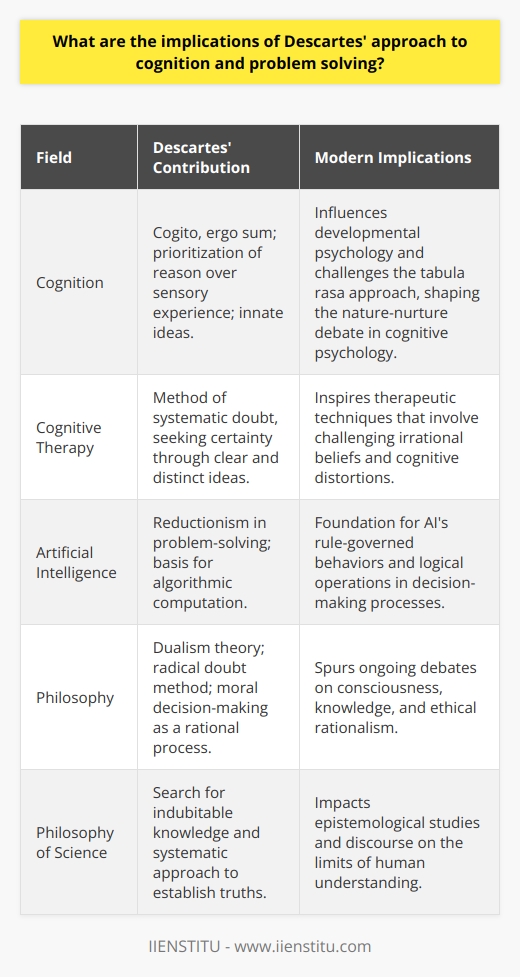
How did Descartes' philosophical ideas contribute to the development of the mind-body problem in cognitive psychology?
Descartes' Influence on the Mind-Body Problem
The mind-body problem in cognitive psychology can trace its roots to the philosophical ideas of René Descartes, a 17th-century French philosopher. Descartes' dualist approach posited that the mind and body are distinct yet interconnected entities.
Separation of Mind and Body
Descartes' most significant contribution to the mind-body problem lies in his assertion that the mind (or soul) is immaterial and non-spatial, while the body is a physical, spatial entity. He argued that the mind's essence is thinking, while the body's essence is extension. This separation allowed for the development of psychological theories that could explore the connection between the two entities without being limited by the constraints of physical matter.
Interactionism and the Pineal Gland
Descartes also postulated that the mind and body interacted through the pineal gland, a small organ deep within the brain. Although we now understand the pineal gland's primary function as hormone regulation, Descartes' emphasis on neurological structures as potential mediators of mental processes was groundbreaking at the time. His efforts laid the foundation for the exploration of the neural correlates of thought and the quest to understand how the brain produces our conscious experiences.
Challenges to Descartes' Dualism
Descartes' ideas have faced many challenges over the years, leading to the development of new theories on the mind-body problem. Materialist perspectives, such as those of contemporary cognitive psychology, argue that mental processes are emergent properties of the brain's physical activities. This stance is at odds with Descartes' dualism, which posits that the mind and body are fundamentally separate substances. Nevertheless, Descartes' influential work remains a central element of the ongoing discussion in both philosophy and psychology.
Conclusion
In summary, Descartes' philosophical ideas significantly contributed to the development of the mind-body problem in cognitive psychology. His dualism established the distinct nature of the mind and body, while his theories about the interaction between the two entities, particularly his focus on the pineal gland, stimulated further scientific inquiry. Though his ideas have been challenged, Descartes' influence on the field remains evident as modern psychologists continue to explore the complexities of the mind and its relationship to the physical world.

In what ways did Descartes' method of doubt serve as a foundation for modern scientific inquiry and empirical methods?
Method of Doubt: Descartes' Foundation
Descartes' method of doubt played a crucial role in laying the groundwork for modern scientific inquiry and empirical methods. By employing rigorous skepticism, Descartes aimed to seek indubitable knowledge and discard any beliefs or ideas that could be subject to doubt.
Establishing Certainty in Knowledge
This method contributed to refining scientific inquiry, as it emphasized the importance of establishing certainty in knowledge. Consequently, scientists began seeking evidence to support their claims, transforming the way knowledge was acquired and understood. Descartes' method prompted an increasing reliance on empirical observations and experiments, ultimately shaping modern scientific practice.
Objective and Systematic Inquiry
Additionally, Descartes' skepticism contributed significantly to fostering objectivity in scientific investigations. By questioning the validity of his own beliefs, he promoted a systematic and unbiased inquiry into the natural world. This approach allowed scientists to eliminate personal biases and conduct investigations focused on empirical evidence, engendering more accurate and reliable results.
Logical and Analytical Reasoning
Another critical aspect of Descartes' method was the adoption of logical and analytical reasoning in scientific inquiry. This approach led to the development of rigorous methodologies and scientific principles, enabling researchers to draw conclusions based on systematic analysis and sound reasoning. Consequently, this fostered the birth of disciplines like physics and chemistry, grounded in mathematical principles and deductive logic.
Epistemological Shift
Descartes' method of doubt also facilitated a significant epistemological shift in the scientific community. The prevailing belief during the medieval period was that knowledge could only be acquired through divine revelation, a notion that shifted with the rise of Descartes' skepticism. By emphasizing doubt and questioning, Descartes displaced theology as the primary source of knowledge and paved the way for a new epistemological paradigm based on empirical observations and reasoning.
In conclusion, Descartes' method of doubt served as a vital foundation for the development of modern scientific inquiry and empirical methods. By fostering skepticism, objectivity, analytical reasoning, and an emphasis on empirical evidence, Descartes' ideas revolutionized the scope and nature of scientific investigations, steering the course of human knowledge toward the pursuit of well-founded, verifiable truths.
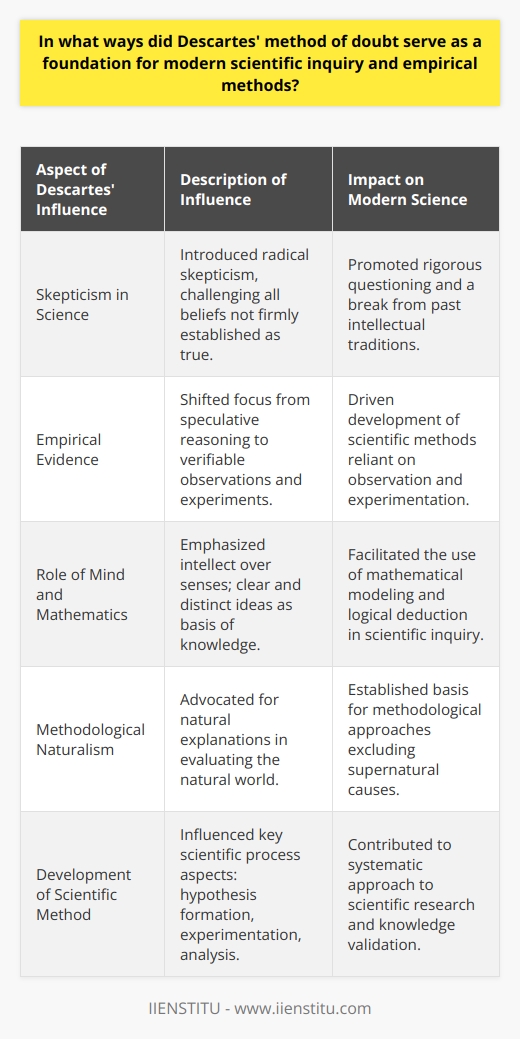
How did Descartes' mechanistic view of the human body and its interaction with the environment shape subsequent theories in cognitive science?
Descartes' Mechanistic Approach
Descartes' mechanistic view of the human body can be considered as the foundation of modern cognitive science. He postulated that the human body is akin to a machine, an intricate network of mechanical components that interact with the environment through sensory perception and create meaningful outputs as behavior.
Mind-Body Dualism
An essential aspect of Descartes' framework is the concept of mind-body dualism, separating the realm of subjective conscious experience (mind) from the physical, objective world (body). Consequently, this division set the stage for the study of mental processes as distinct from purely physiological processes, paving the way for the development of cognitive science as a distinct field of inquiry.
The Mechanistic Model
Descartes' mechanistic model provided a strong impetus for researchers to systematically analyze the behavioral and cognitive outcomes of sensory information processing. The idea that sensory input is transformed into meaningful actions mirrors modern approaches in cognitive science, which emphasize the role of information processing in understanding mental processes such as memory, learning, and decision-making.
Reflex Arc Theory
Descartes also proposed the idea of the reflex arc to explain the involuntary responses of the body to external stimuli. This theory laid the groundwork for understanding the role of neural networks and their role in mediating the interactions between the body and environment in cognitive processes.
Influence on Behaviorism
Moreover, Descartes' mechanistic philosophy has proved influential in shaping theories within behaviorism, an influential school of thought in cognitive science. Behaviorists, much like Descartes, perceive organisms as machines reacting to the environment through a series of stimulus-response mechanisms, leading to the development of systematic methods for studying and manipulating cognitive processes.
Conclusion
In summary, Descartes' mechanistic view of the human body and its interaction with the environment profoundly shaped subsequent theories in cognitive science. His ideas on mind-body dualism, the mechanistic model, reflex arc theory, and their influence on behaviorism contributed to the systematic investigation of mental processes and the emergence of cognitive science as a distinct field of study.
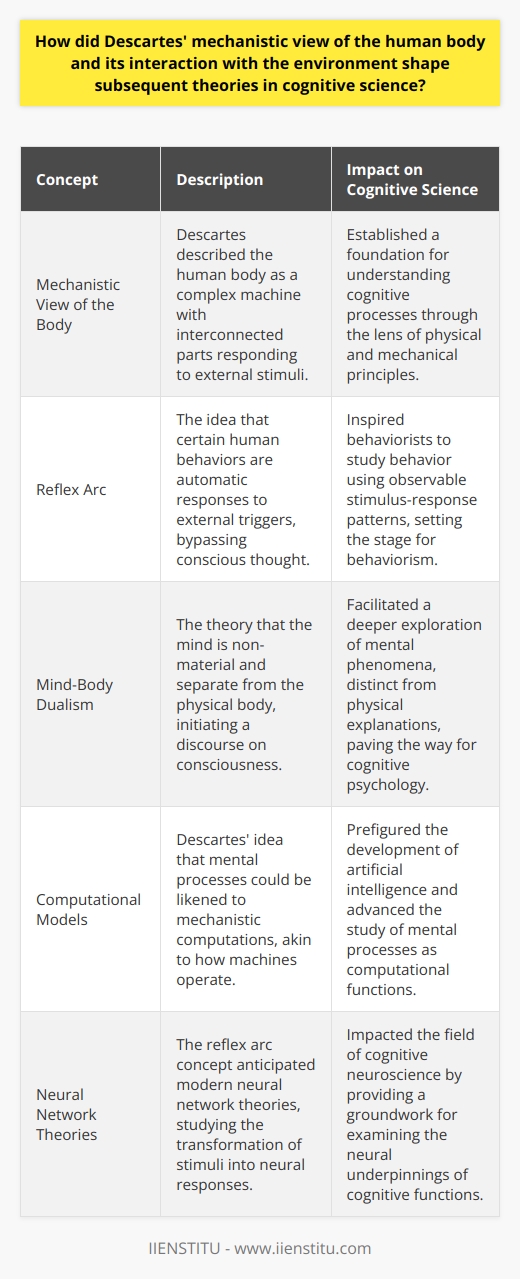
How did Descartes influence cognitive psychology?
Descartes' Impact on Cognitive Psychology
Rene Descartes, a French philosopher and mathematician, greatly influenced the development of cognitive psychology through his work on the relationship between the mind and the body. Descartes is best known for his famous quote, 'Cogito, ergo sum' (I think, therefore I am), which emphasizes the importance of thought and cognition in understanding human existence.
Dualism and Cognition
Central to Descartes' contribution is his dualism theory, which posited that the mind and body are distinct entities that interact with each other. This view provided a critical foundation for subsequent theories in cognitive psychology, particularly those focusing on how mental processes relate to physical actions and behavior.
Innate Ideas and Learning
Another significant contribution from Descartes to cognitive psychology is the concept of innate ideas. He argued that humans were born with specific knowledge and understanding, which subsequently influenced their thoughts and perceptions. This assertion contrasted with the prevailing philosophical view that humans acquire all knowledge through experience or learning, laying the groundwork for future research on the role of innate factors in cognitive development.
Mechanistic View of the Brain
Descartes also pioneered a mechanistic view of the brain, where neurological activity was likened to a complex system of machinery. He believed that certain reflexes were automatic, involuntary reactions to specific stimuli, which could provide valuable insights into the workings of the mind. This perspective has greatly influenced modern cognitive psychology, particularly in the field of neural networks and computational models of cognition.
Rationalism and Reasoning
In addition to his explorations of the mind-body connection, Descartes is known for his philosophical approach to rationalism, which emphasized the role of reason and logical deduction in the acquisition of knowledge. This reliance on structured, analytical thinking has had a lasting impact on cognitive psychology, particularly in areas such as problem-solving, decision-making, and cognitive processes that require logical and deductive reasoning.
In conclusion, Rene Descartes' contributions to the development of cognitive psychology are profound, from his dualistic view of the mind-body connection, to innate ideas and learning, to mechanistic perspectives on brain function, and finally to his rationalist approach to reasoning. His ideas have shaped the course of cognitive psychology and continue to influence research and understanding in the field today.
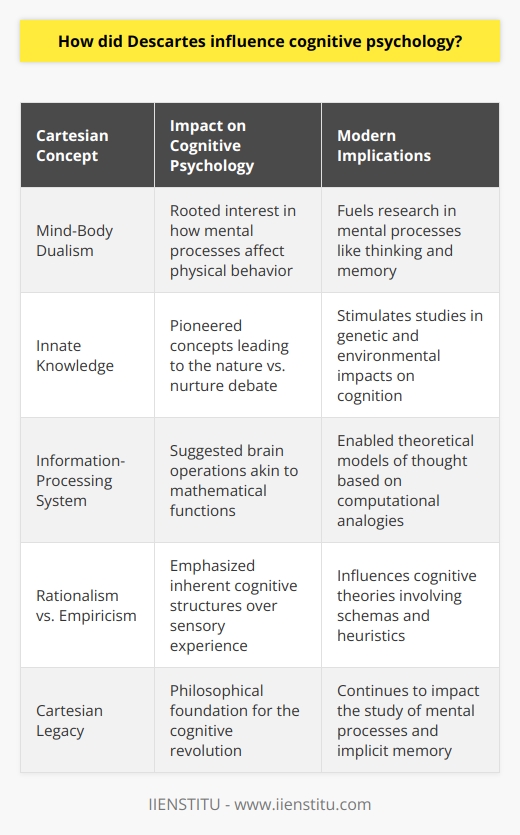
What is Descartes method of learning?
Subheadings: Defining the Method, The Four Rules, Applying the Cartesian Method
Defining the Method
Descartes' method of learning, known as the Cartesian Method or 'Method of Doubt,' is a systematic investigative process which aims to acquire certain knowledge through a series of logical reasoning steps. Descartes championed the use of reason and rationality as a means to acquire knowledge, rather than relying solely on empirical observation or received opinions.
The Four Rules
The Cartesian Method comprises four main rules that govern the critical thinking process. Firstly, the rule of 'evidence' demands that only evident and unambiguous ideas be considered true. Secondly, the rule of 'analysis' involves breaking down complex problems into simpler, manageable parts, facilitating comprehension. The third rule, 'synthesis,' necessitates reconstructing a complete understanding of the original problem by synthesizing the solutions to the simpler elements. Finally, the rule of 'enumeration' calls for a thorough review of the logical steps taken to ensure no errors have been made in the reasoning process.
Applying the Cartesian Method
By adhering to these four rules, Descartes believed one could progress from doubt to certainty, effectively establishing an indubitable foundation for knowledge. This method of systematic doubt is best exemplified by his famous dictum, 'Cogito, ergo sum' (I think, therefore I am). Descartes arrived at this conclusion by doubting everything, even his own existence, and then determining that the act of doubting itself confirmed his existence as a thinking being. This realization served as the starting point for further inquiry, leading to a comprehensive and rational understanding of the nature of knowledge, reality, and the human mind.

What was Descartes method of acquiring knowledge?
Analyzing Descartes' Method
Descartes' approach to gaining knowledge can be encapsulated in his method of doubt, a system grounded in skepticism, introspection, and the pursuit of certainty.
Fundamentals of Method of Doubt
At its core, the method of doubt aimed to remove all assumptions and beliefs that could be subject to doubt, ensuring that only absolute truths remained. Descartes' process involved three main steps: radical doubt, the Cogito, and building a new foundation for knowledge.
Radical Doubt
In the first stage, Descartes doubted everything he had previously accepted as true. He questioned the reliability of sensory perception, the existence of the external world, and even the existence of his own body. This exhaustive scrutiny allowed him to discard any belief that could be subject to doubt.
The Cogito
As Descartes progressed through his method, he reached the conclusion that, despite his doubt, his thinking could not be refuted. This realization led to the famous Cogito Ergo Sum principle, translating to 'I think, therefore I am.' The Cogito served as the foundational truth upon which Descartes would build his new body of knowledge.
A New Foundation for Knowledge
With the Cogito established as the bedrock, Descartes then sought to reconstruct his understanding of reality. He employed deductive reasoning and logical principles in order to uncover clear and distinct ideas, which were considered incontrovertible. Among these ideas, Descartes deduced the existence of God and the distinction between the mind and body.
Impact and Legacy
Descartes' methodology has had a lasting influence on both philosophy and science. His method of doubt paved the way for critical thinking, skepticism, and rationalism in the Western intellectual tradition. Additionally, the rigorous and systematic logic embedded in his approach has laid the groundwork for modern scientific inquiry.
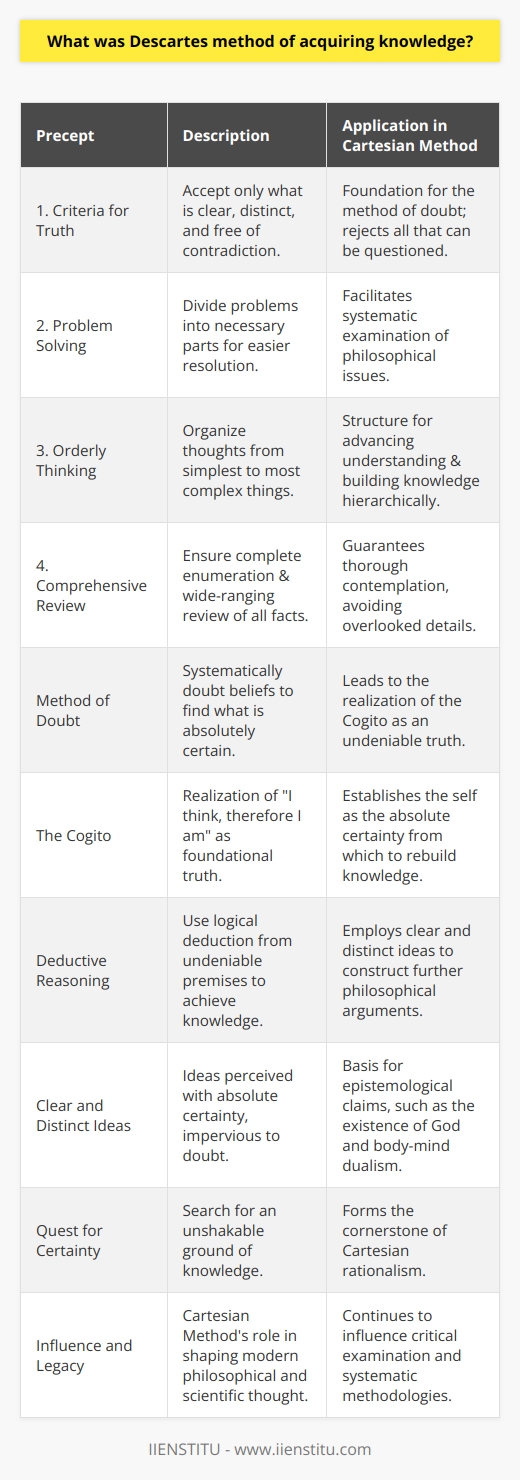
What is the cognitive theory of Descartes?
Descartes' Cognitive Theory: Overview
The cognitive theory of Descartes, a 17th-century French philosopher, emphasizes the importance of the mind in understanding human behavior and knowledge acquisition. René Descartes is well-known for his philosophical statement 'Cogito, ergo sum,' which means 'I think, therefore I am.' This encapsulates his core belief that a person's existence is primarily grounded in their ability to think and reason.
Role of Rationalism in Cognitive Theory
In Descartes' cognitive theory, rationalism plays a central role. Rationalism suggests that knowledge is primarily acquired through innate ideas and logical reasoning instead of sensory experience or observation. Descartes advocated for the use of critical thinking and deductive reasoning to understand the world around him, arguing that essential truths could be discovered by solely examining one's own thoughts and logical processes.
Dualism: Mind-Body Interaction
Another significant aspect of Descartes' cognitive theory is his concept of dualism, which claims that the human consists of two separate entities: the mind and the body. The mind represents the cognitive, and the body represents the physical. These two components interact, but they are fundamentally distinct. According to Descartes, the mind is not just a by-product of the body, but rather, it possesses its own unique existence and capabilities. This idea contrasts with the later materialist philosophies that view the mind as an outcome of physical processes occurring within the brain.
Innate Ideas and Knowledge
Descartes postulated that humans are born with certain innate ideas, which serve as the foundation for knowledge acquisition. These innate ideas exist independently of any sensory input or external experience. Descartes believed that some knowledge, such as mathematical truths and the existence of God, is already embedded within our minds and can be revealed through the process of rational thought and introspection.
Criticism and Influence
Although Descartes' cognitive theory significantly contributed to the development of modern psychology and philosophy, it has also faced criticism. Critics argue that the theory overly emphasizes the power of innate knowledge and rational thought while undermining the role of sensory experience and empirical observations. Nonetheless, Descartes' ideas have had a lasting impact on cognitive psychology, epistemology, and the broader field of philosophy. His work laid the groundwork for later theories of cognition and continues to be influential today.
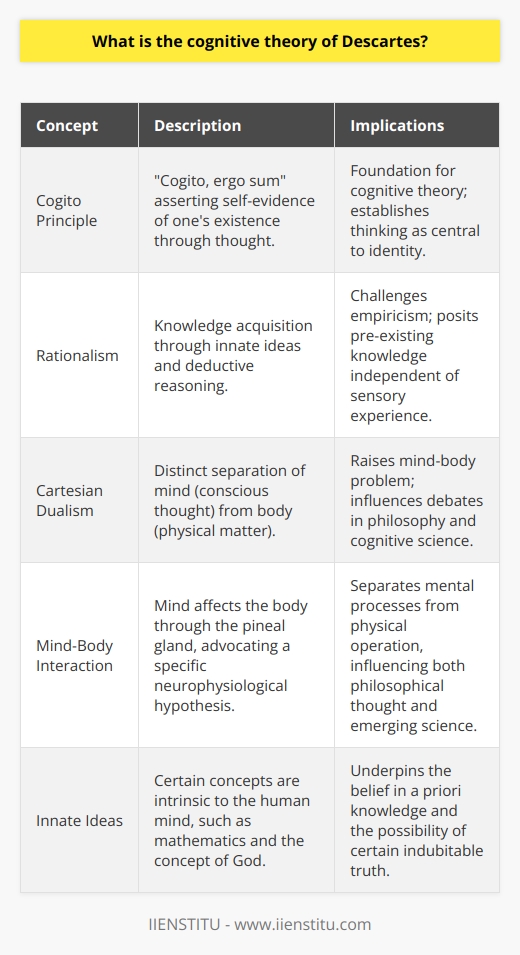
What is the concept of cognition and problem solving?
Concept of Cognition
The concept of cognition refers to mental processes that facilitate the acquisition, processing, storage, and retrieval of information. These processes are crucial components of human intelligence and encompass functions such as perception, attention, memory, reasoning, and decision-making. By engaging in cognitive activities, individuals can make sense of their environment, interact with others, and navigate through various challenges in life.
Role of Cognition in Problem Solving
Problem-solving is one of the essential cognitive processes that enable individuals to identify issues, generate potential solutions, evaluate alternatives, and select the most appropriate course of action. This process often involves a series of cognitive skills such as observational analysis, pattern recognition, and critical thinking. These skills contribute to the ability to systematically analyze complex situations, discern critical factors, and devise effective strategies to address problems.
Cognitive Strategies in Problem Solving
Several cognitive strategies have been identified as vital components of effective problem-solving. One such strategy is the application of heuristics, which are mental shortcuts or rules of thumb that simplify complex tasks and facilitate quicker decision-making. Another strategy is analogical reasoning, wherein individuals draw upon prior experience and knowledge of similar situations to generate solutions for new problems. A third strategy involves the use of metacognition, or thinking about one's thinking, to monitor and regulate cognitive processes during problem-solving.
Obstacles in Cognitive Problem Solving
During the problem-solving process, individuals may encounter obstacles that hinder their ability to effectively analyze and resolve issues. Cognitive biases, such as confirmation bias and availability heuristic, can lead to errors in judgment and impede objective decision-making. Additionally, limitations in working memory capacity and cognitive resources can impact the efficiency and accuracy of problem-solving efforts. Finally, the inherent complexity and ambiguity of certain problem domains may pose substantial challenges for cognitive processing.
Enhancing Cognitive Problem Solving Skills
To improve cognitive problem-solving abilities, individuals can engage in activities that foster the development of relevant cognitive skills. These may include practicing reflective thinking, engaging in critical analysis and discussion, and refining decision-making processes through case studies and simulations. Additionally, enhancing metacognitive awareness and embracing a growth mindset, characterized by a belief in one's ability to learn and improve, can contribute to more adaptive and effective problem-solving approaches.
In summary, cognition is a complex and multifaceted concept that plays a pivotal role in the process of problem-solving. By understanding and nurturing relevant cognitive processes and strategies, individuals can improve their problem-solving skills and adapt more effectively to various challenges and opportunities in life.
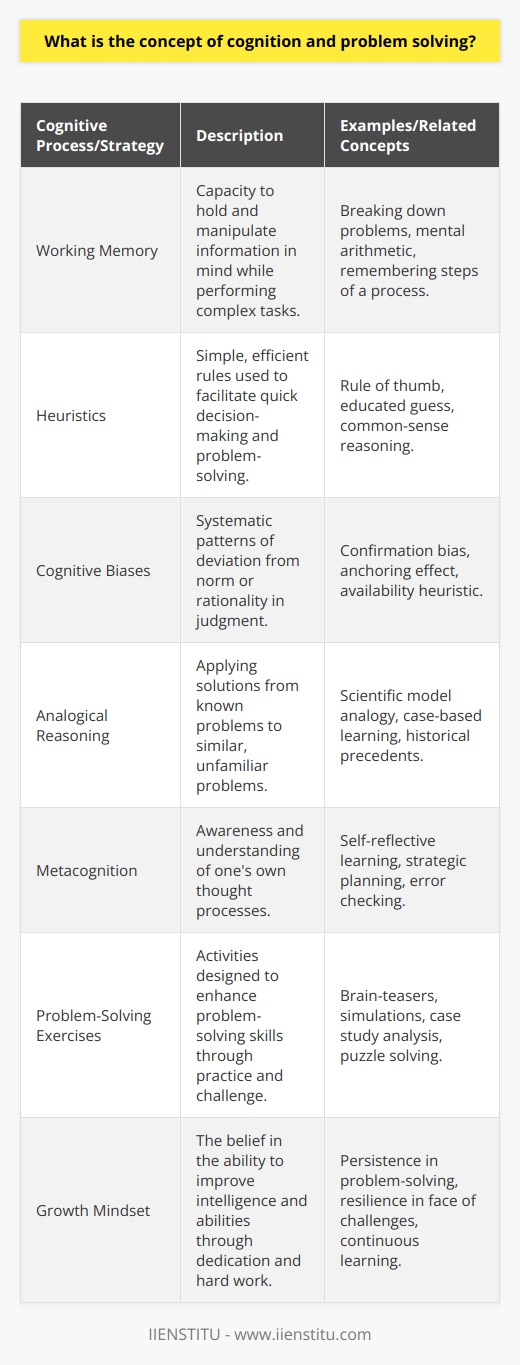
How did Descartes influence cognitive psychology?
Descartes' Contributions to Cognitive Psychology
Rene Descartes, a French philosopher, mathematician, and scientist, significantly influenced cognitive psychology with his groundbreaking ideas. He is often referred to as the father of modern philosophy, thanks to his intellectual contributions that laid the foundation for cognitive psychology.
The Dualism Principle
Descartes posited the concept of mind-body dualism, which contends that the mind and body are separate entities. Cognitive psychologists adopted this dualism idea, focusing on mental processes as distinct from physiological functions. As a result, modern cognitive psychology primarily investigates non-physical aspects of the human mind, including memory, perception, and problem-solving.
The Role of Innate Ideas
Descartes also advocated for the existence of innate ideas, suggesting that certain knowledge is innate to human beings. This concept contributed to the development of cognitive psychology in the nature versus nurture debate, addressing whether specific cognitive processes are inborn or determined by external environment and experience.
The Systematic Doubt Method
Lastly, Descartes introduced the method of systematic doubt, questioning all presumed knowledge to attain fundamental truths. This approach led cognitive psychologists to examine mental processes and human cognition through systematic, empirical research methods. Descartes' method paved the way for the scientific study of cognitive processes, fostering its credibility and rigor in the scientific community.
In conclusion, Descartes played a crucial role in shaping cognitive psychology through his ideas on dualism, innate ideas, and the method of systematic doubt. These concepts have fostered cognitive psychology's theoretical foundations, facilitating its growth as a scientific discipline. As a result, Descartes' influence on cognitive psychology remains an essential aspect of modern psychological study.

What role does Descartes' dualism play in the development of cognitive psychology?
Role of Descartes' Dualism
Descartes' dualism, which separates mind and body, laid the groundwork for cognitive psychology by asserting the existence of an immaterial mind capable of cognition. He suggested that mental processes are functions of a non-material mind, different from the physical body. This distinction allowed researchers to focus on the mental processes (such as thinking, problem-solving, and memory) that underpin human behavior.
Influence on Cognitive Psychologists
Through this lens, cognitive psychology emerged as a field of study exploring internal mental processes. Descartes' dualism provided a framework for understanding the mind as an entity beyond physical limitations. His ideas have significantly impacted cognitive psychologists who investigate cognitive, affective, and psychomotor skills in the context of learning and mental task performance.
Disagreements and Alternatives
However, Descartes' dualism is not without controversies. Critics argue that his theories lack scientific evidence and rely heavily on philosophical deduction. They contend that dualism cannot provide a satisfactory explanation for the complex interactions between the mind and the body. In response, alternative perspectives like cognitive neuroscience have emerged to fill gaps in the understanding of the mind-body relationship. These approaches seek to integrate the study of mental processes with findings from neuroscience, effectively bridging the gap between the dualistic perspectives of Descartes and modern-day understandings of the brain's role in cognitive processing.
Conclusion
Despite these controversies, Descartes' dualism has undoubtedly played a crucial role in defining cognitive psychology as a field of study. By offering a theoretical basis to investigate the mind's inner workings, Descartes' ideas have served as a catalyst for cognitive psychology's growth and development. As research in this field continues to evolve, the underlying concepts of dualism remain central to understanding the many facets of human cognition.
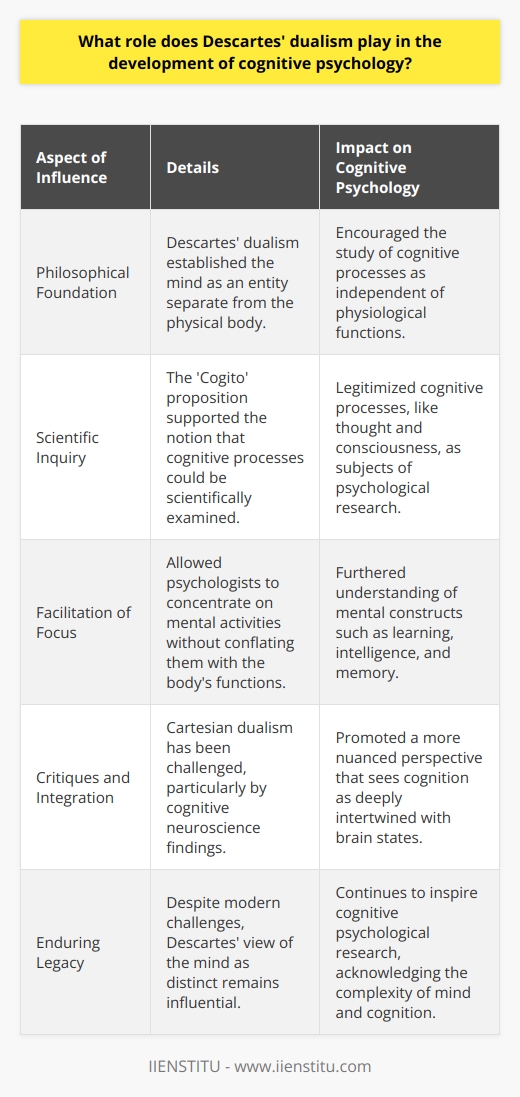
How does Descartes' method of doubt contribute to our understanding of human cognition and problem-solving strategies?
Descartes' Method of Doubt and Human Cognition
Descartes' method of doubt, often referred to as Cartesian doubt, is a philosophical approach that involves systematically doubting beliefs to arrive at certain knowledge. This heuristic can be applied to the study of human cognition and problem-solving strategies, as it offers insights into the processes by which we evaluate our own understanding and recognize the validity of our ideas.
Skepticism as a Tool for Cognitive Reflection
Adopting a skeptical approach, as Descartes' method of doubt suggests, can help us become aware of our own cognitive biases. By questioning the accuracy of our perceptions and beliefs, we can challenge our assumptions and make more informed decisions. This process encourages us to reflect on our own thought processes and critically examine the reasoning behind our judgments.
Enhancing Problem-Solving Strategies through Rigorous Analysis
Descartes' method of doubt can also be instrumental in refining our problem-solving abilities. By systematically doubting and scrutinizing each step of the problem-solving process, we can identify errors in our reasoning and develop more effective solutions. This level of critical analysis fosters a more disciplined approach to problem-solving, reducing the likelihood of succumbing to cognitive shortcuts or misjudgments.
Facilitating Intellectual Growth through Doubt
Furthermore, embracing doubt can lead to intellectual growth by prompting us to explore new ideas and perspectives. Questioning beliefs might result in the reconsideration of outdated or inaccurate knowledge, paving the way for the acquisition of new information and the development of more accurate beliefs. In this sense, Descartes' method of doubt can support the expansion of our cognitive capacities and facilitate more effective problem-solving strategies over time.
In conclusion, Descartes' method of doubt contributes significantly to our understanding of human cognition and problem-solving strategies. By fostering a sense of skepticism, it encourages us to be aware of cognitive biases, analyze problems more rigorously, and engage in intellectual growth. Applying Cartesian doubt to our thinking processes can ultimately enhance our problem-solving abilities and support the continuous development of our cognitive capacities.
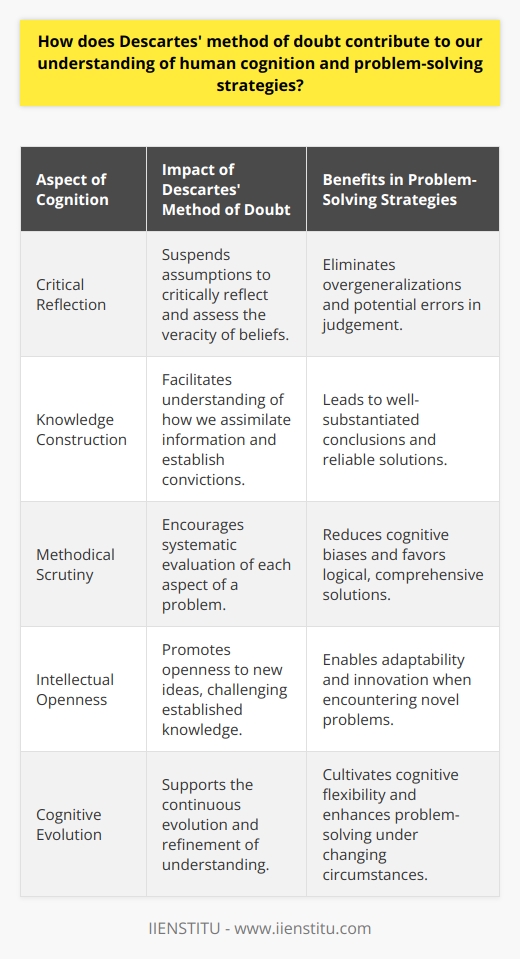
In what ways did Descartes' philosophical ideas pave the way for the emergence of cognitive psychology as a distinct discipline?
Descartes' Contributions to Cognitive Psychology
Philosophical Foundations
Descartes' philosophical ideas significantly contributed to the development of cognitive psychology by establishing a critical foundation. His dualism concept separated the mind from the body, asserting that the mind is a distinct entity. This separation created the basis for considering mental processes as a vital subject of scientific inquiry, ultimately leading to the emergence of cognitive psychology as a unique field.
Emphasis on Mental Processes
Another way Descartes facilitated the emergence of cognitive psychology was through his emphasis on the role of mental processes in shaping human behavior and experiences. He believed that mental operations like thinking, reasoning, remembering, and imagining influenced human actions. This understanding of the mind's role in behavior paved the way for future research in cognitive processes, a central aspect of cognitive psychology.
Rationalism and Innate Ideas
Descartes' rationalist perspective also played a crucial role in developing cognitive psychology. He argued that some ideas are innate, embedded in humans since birth. This perspective contradicted empirical thought, which suggested that knowledge comes solely from experience and observation. Descartes' rationalism allowed researchers to consider the idea that mental abilities and processes could be studied independent of empirical data, further reinforcing the study of cognitive psychology.
Introspection and Subjective Experience
Finally, Descartes championed introspection as a valid approach to understanding human cognition. He maintained that individuals could gain insight into their mental processes by observing and reflecting on their own thoughts and experiences. Descartes' introspection method paved the way for later psychologists to examine the subjective nature of cognitive processes, eventually leading to the establishment of cognitive psychology as a distinct discipline.
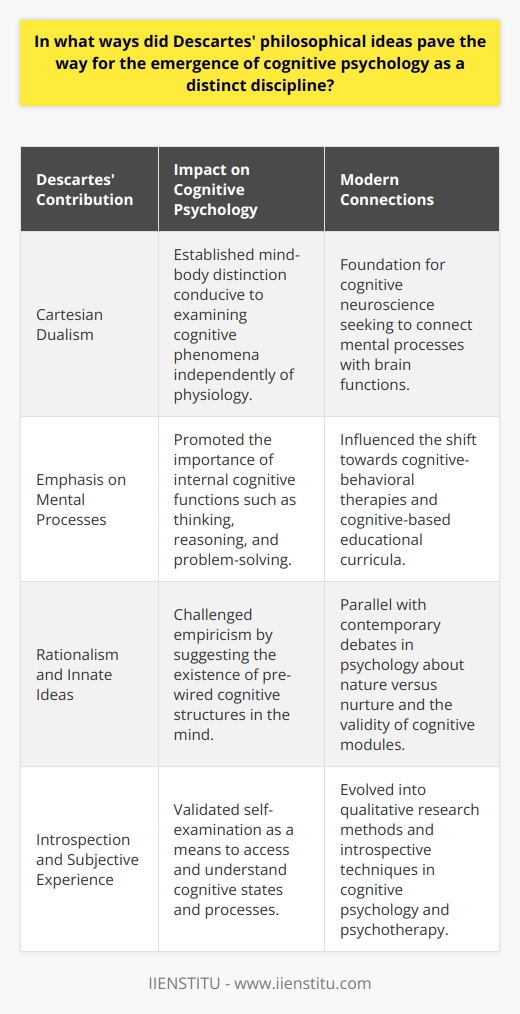
What is the concept of cognition and problem solving according to Descartes?
Descartes and the Concept of Cognition
Rene Descartes, a key figure in the history of philosophy, identified cognition as a process involving total awareness and comprehension. He viewed it as an integral part of the human thought process. In his Mental Ideas philosophy, he labelled cognition as the capacity to perceive, understand, and choose.
Process of Cognition in Descartes’ View
Descartes admired rational thinking. He asserted that human minds possess inherent ideas or truths. He suggested that knowledge does not come from senses alone, but also from the intellect. Descartes stated cognition could arise from innate ideas independent of sensory experience, and by deductive reasoning one can achieve accurate understanding of things.
Problem Solving according to Descartes
He also had important insights about problem solving. He encouraged a methodical approach in order to understand and resolve issues. Descartes advised breaking complex problems into simpler, comprehensible parts. This way, one can tackle issues from the simplest to the most complex sequentially.
Descartes on Cognitive and Problem-Solving Methodology
To Descartes, systematic doubt was crucial in cognition and problem-solving methodology. By doubting, one could eliminate false beliefs and ultimately comprehend the truth. Overall, Descartes' approach to cognition and problem-solving emphasizes the prominence of inherent ideas, deductive reasoning, systematic doubt and the methodical resolution of issues.
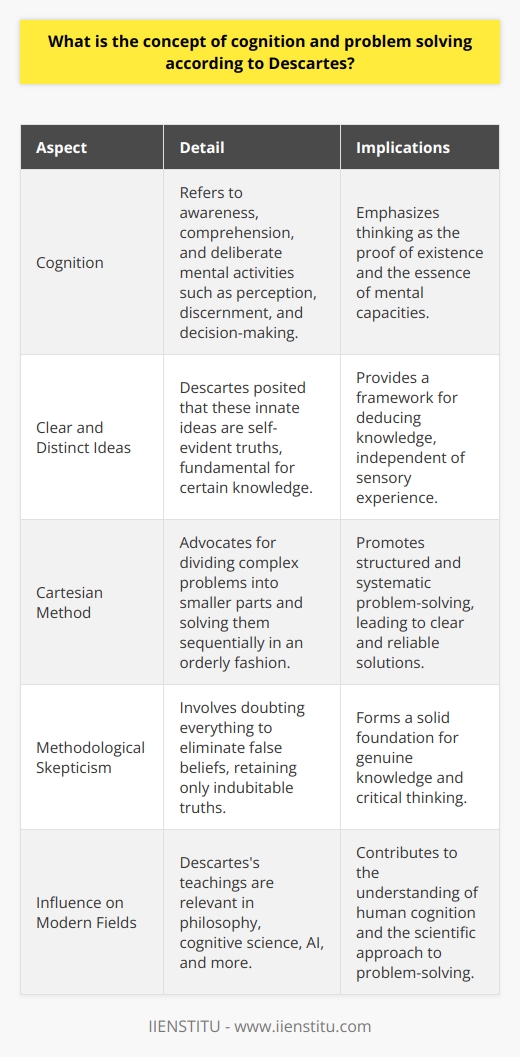
How do you solve a problem using René Descartes' method?
Understanding the Cartesian Method
René Descartes' problem-solving method involves radical doubt and systematic analysis. In this approach, one begins by questioning everything up to a necessary truth.
Process of Radical Doubt
The initial stage, radical doubt, asks us to suspend any belief and doubt everything. We do not assume anything as true unless it presents itself as such, clearly and distinctly. This stringent criterion ensures a clean slate for further inspection.
Moving to Clear and Distinct Ideas
This leads us to clear and distinct ideas, concepts that withstand the lens of doubt. These ideas serve as the foundation for further analysis. We accept these as 'indubitable' truths. They are self-evident and easily understandable facts.
Applying Deductive Reasoning
Once we establish these foundational truths, we employ deductive reasoning. This method uncovers additional truths linked to our indubitable concepts. We draw logical inferences from the clear and distinct ideas, leading to a chain of truths.
Integrating Systematic Analysis
The application of systematic analysis further solidifies our findings. This process involves examining each aspect of the problem in a precise, sequential manner. It enables us to uncover more complex ideas from our foundational truths.
Ordered Synthesis to Final Solution
The final step is ordered synthesis. We begin by understanding simpler concepts, gradually progressing to more complex ideas. By compiling these individual pieces of knowledge, we form the complete solution to our problem.
Descartes' method thus presents a rigorous and systematic approach to problem-solving. It guarantees the reliability of the solution by firmly anchoring it in clear and distinct ideas. This methodology can be applied to various disciplinary contexts, be it philosophy, science or mathematics, enhancing academic studies.

What are the 4 main steps of Descartes' discourse on method and how do they relate to problem solving?
Understanding Descartes' Method
The 4 main steps of Descartes' Discourse on Method propose a systematic approach to problem-solving.
Step One: Skepticism
The first step involves a process of deconstruction or skeptical doubt. Descartes suggested suspending all beliefs, leading to a state where no assumptions can interfere with the investigation. This step aids problem-solving by preventing us from prematurely accepting solutions that may not be valid.
Step Two: Analysis
The second step, analysis, involves the process of breaking down a complex problem into its simplest possible components. By understanding these components separately, we are better equipped to grasp the overall issue. Applied to problem-solving, this analytical approach simplifies a complex issue, making it easier to tackle.
Step Three: Synthesis
Thirdly, synthesis requires reconstructing the whole issue from its analyzed parts. Descartes advised starting from the simplest ideas and progressively combining them to address the more complex ones. This step promotes an orderly approach to problem-solving, ensuring that every potential contributing factor to the issue gets proper consideration.
Step Four: Review
Finally, Descartes recommended a comprehensive review, where we test the newly reconstructed ideas against rigorous scrutiny to ensure no mistakes. In problem-solving terms, this acts as a quality check, ensuring the selected solution is valid and thorough.
In conclusion, Descartes’ method can be seen as a holistic and systematic approach to problem-solving, involving critical doubt, decomposition, rebuilding and confirmation. It aligns closely with modern problem-solving methodologies, underlining its continued relevance.
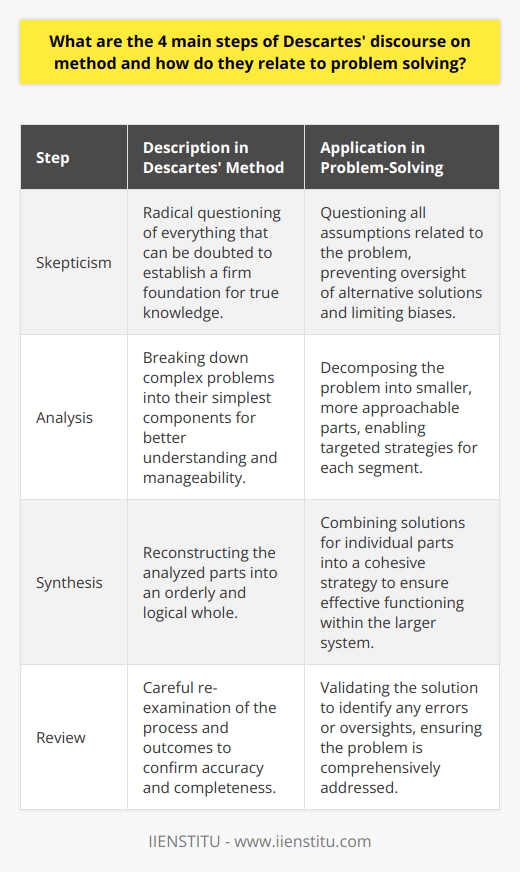
What is the relationship between Descartes' dualism and the cognitive processes involved in problem solving?
Descartes' Dualism and Cognitive Processes
Descartes' dualism, often termed as mind-body dualism, profoundly influences our understanding of cognitive processes. Central to this philosophy is the assertion that the mind and body are two distinct entities. In the context of problem-solving, this dualistic view is pivotal.
Understanding the Dualistic Approach
By positing the mind as non-physical and the body as physical, Descartes outlines a division between mental and physiological processes. Problem-solving primarily falls under mental processes which are subjective and conscious experiences. These processes entail the mind's engagement, isolated from the body's physical involvement.
Implications for Problem-Solving
The direct relationship between Descartes' dualism and problem-solving reveals itself in the cognitive processes. Problem-solving involves cognition - the mental action or process of acquiring knowledge and understanding. This, in itself, is a manifestation of Descartes' mind attribute. He claimed that the mind endows us with capacities for thinking, understanding, learning, and experiencing emotions - the quintessential elements in problem-solving.
Dualism and Cognitive Science
Contemporary cognitive science embraces Descartes' dualism. The cognitive approach to problem-solving fosters focus on mental strategies. Considerations include memory, attention, critical thinking, perception, and language. These elements personify Descartes' mind concept, segregating physiological functions from cognitive ones in problem-solving.
To conclude, Descartes' dualism offers comprehensive insights into problem-solving's cognitive processes. It highlights an undeniable connection between the metaphysical mind and cognitive science's empirical methodologies. As we continue dissecting cognitive functions in humans, we invariably echo Descartes’ enduring philosophical legacy in understanding mind-body dualism.

How does Descartes' philosophical approach inform the study of cognition and problem-solving strategies in contemporary cognitive psychology?
Descartes and Cognitive Psychology
Descartes, a French philosopher, significantly influences the field of contemporary cognitive psychology. His philosophical approach, particularly his proposition of dualism, contributes to the way we understand cognition and problem-solving.
Understanding Dualism
Dualism discusses the existence of two distinct elements: the mind and the body. Descartes suggests these elements hold entirely separate entities that inherently interact. This notion has a considerable effect on how cognitive psychologists approach the study of cognition.
Influence on Cognitive Processes
Contemporary cognitive psychology adopts Descartes’ idea, often studying cognitive processes such as reasoning, memory, and language as separate functions. These independent processes then collectively contribute to overall cognition and problem-solving.
Problem Solving Strategies
Cognitive psychologists also leverage Descartes' method of 'systematic doubt,' a key element in his approach to achieve certain knowledge. This strategy is often employed when considering problem-solving and decision-making strategies, particularly in the aim to reduce bias and errors.
Descartes' Impact on Experimental Methods
Moreover, Descartes’ advocacy for empirical evidence and deductive reasoning has shaped the methodology within the field. Cognitive psychologists continue to use experimental methods to quantify and observe cognitive processes, firmly following Descartes' push for observable and measurable data.
Overall, the profound influence of Descartes’ philosophical perspective has significantly shaped and continues to inform the study of cognition and problem-solving strategies in contemporary cognitive psychology. His dualism proposition and method of systematic doubt provide a framework for understanding cognitive processes and formulating effective problem-solving strategies, while his emphasis on empirical evidence and deductive reasoning underscores the importance of robust and observable data in the field.

In what ways did Descartes' method of philosophy influence the development of cognitive processes for problem-solving?
Rationalism and Problem Solving
Descartes' philosophy introduces rationalism, a concept profoundly influencing problem-solving processes. The Cartesian method values reasoning and logic, transforming the cognitive process of solving issues.
Mathematical Reasoning
He urged to use mathematical reasoning for non-mathematical issues. This methodology aims to break down complex problems into simpler parts, akin to mathematical procedures. This strategy considerably enhances understanding and decision-making processes.
Skepticism and Problem Exploration
Descartes' skepticism towards existing knowledge enacted the constant questioning of established concepts. This compels a more thorough exploration of problems. Complete understanding forms the foundation for effective problem-solving.
Introspection and Self-evaluation
His philosophical approach promotes introspection. This self-evaluation mechanism motivate individuals to examine personal biases, bettering the quality of problem analysis and solution formulation.
Evidence-based Problem-solving
Descartes favored deductive reasoning over reliance on senses or experiences. This focus on concrete evidence placed greater emphasis on systematic, objective problem exploration. Consequently, it bolstered problem-solving efficacy through an evidence-based approach.
Descartes’ Influence on Modern Problem-solving
Descartes significantly shaped modern problem-solving methods. His philosophical tenets stressed logic, skepticism, introspection, and evidence. These principles encourage clear, rational thinking, improving our capacity to tackle complex issues effectively. Thus, his impact on cognitive processes remains undeniable.
